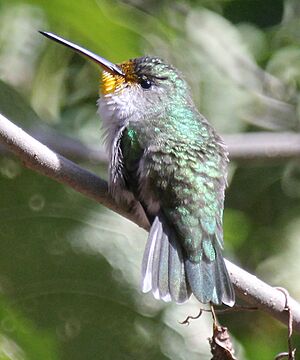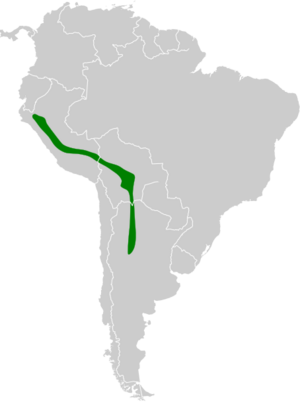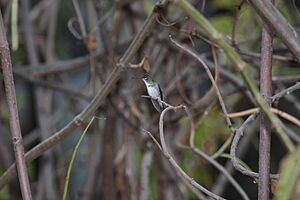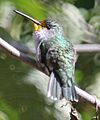White-bellied hummingbird facts for kids
Quick facts for kids White-bellied hummingbird |
|
|---|---|
 |
|
| Conservation status | |
| Scientific classification | |
| Genus: |
Elliotomyia
|
| Species: |
chionogaster
|
 |
|
| Synonyms | |
|
|
The white-bellied hummingbird (Elliotomyia chionogaster) is a tiny, colorful bird. It is a type of hummingbird known for its bright green and white feathers. You can find this amazing bird in parts of Argentina, Bolivia, Brazil, and Peru.
Contents
About the White-bellied Hummingbird
Hummingbirds are known for their ability to hover in the air. They can also fly backward! The white-bellied hummingbird is part of a group often called "emeralds" because of their shiny green feathers.
What's in a Name? The Science of Classification
Scientists give every animal a special name. This helps them organize and study living things. The white-bellied hummingbird's scientific name is Elliotomyia chionogaster.
For a while, this hummingbird was placed in different groups, or "genera," like Leucippus and Elliotia. Until 2014, it was in the group called Amazilia.
Scientists used new studies to look at the birds' DNA. They found that the Amazilia group was not organized in the best way. So, they created a new group called Elliotomyia. Most scientists now agree that the white-bellied hummingbird belongs here.
The white-bellied hummingbird shares its new group, Elliotomyia, with another bird. This bird is called the green-and-white hummingbird. Our white-bellied friend has two slightly different types, or "subspecies." They are called E. c. chionogaster and E. c. hypoleuca.
What Does the White-bellied Hummingbird Look Like?
This hummingbird is quite small. It measures about 9 to 12 centimeters (3.5 to 4.7 inches) long. That's about the length of a pen!
Males are a bit heavier than females. Males weigh about 4.9 to 6.7 grams. Females weigh about 4.5 to 6 grams. That's less than a quarter!
Feather Colors and Bill Shape
Both male and female white-bellied hummingbirds have a medium-length, straight bill. The top part of their bill is blackish. The bottom part is reddish with a dark tip.
Adult males of the main subspecies have bright light green feathers. These cover their upper body, sides, and chest. Their undersides, from their chin to under their tail, are whitish. They might have golden-green spots on the sides of their throat.
Their tail feathers are a shiny grayish green to golden green. The outer tail feathers have white on the inside. Adult females look very much like the males. However, their chin and throat are a light cream color. These areas have more spots. Young birds look like adult females. Their cream color extends to their belly.
Differences in Subspecies
The other subspecies, E. c. hypoleuca, has creamy undersides instead of white. The white parts on the outer tail feathers are smaller. Females of this subspecies also have white tips on their outer three pairs of tail feathers.
Where Do White-bellied Hummingbirds Live?
The main subspecies, E. c. chionogaster, lives on the eastern side of the Andes mountains in Peru. You can find them between the Amazonas and Cuzco regions.
The E. c. hypoleuca subspecies lives further south. They are found from the Puno region in southeastern Peru. Their range extends through Bolivia and into northwestern Argentina. They also live in the Brazilian state of Mato Grosso.
Preferred Homes and Elevations
These hummingbirds like places that are semi-open. This includes the edges of forests and areas where new forests are growing. They also live in shrublands, plantations, and even gardens.
They prefer drier areas. You might find them near cacti, agave plants, or groves of alder or eucalyptus trees. They usually live at elevations between 450 and 2000 meters (1,476 and 6,562 feet). Sometimes, they can be found as high as 2800 meters (9,186 feet).
White-bellied Hummingbird Behavior
These birds generally stay in one place. They don't migrate far. However, some have been seen moving around locally in Argentina.
What Do They Eat?
White-bellied hummingbirds drink nectar from many different kinds of flowers. They visit flowering plants, shrubs, and trees. Scientists have seen them feeding from at least eight different plant families! Besides nectar, they also eat small insects. Insects give them important protein.
Breeding and Life Cycle
The breeding season for the white-bellied hummingbird is from January to March. The female builds a cup-shaped nest. She uses plant fibers and moss. She decorates the outside with lichens.
The nest is usually placed in a shrub or small tree. It's often between 2 and 5 meters (6.5 to 16 feet) above the ground. The female lays two eggs. She sits on them for 14 to 15 days until they hatch. The young birds are ready to leave the nest 19 to 22 days after hatching.
How Do They Communicate? Their Calls and Songs
The song of the main subspecies sounds like "tseet-chew-chip … tseet-chew-chip …" It's a repeated short phrase with three squeaky notes.
The other subspecies, E. c. hypoleuca, sings a series of single, high-pitched "pseek" notes. Sometimes, this is followed by a faster, lower "tsi-tsi-tsi-tsi." Both subspecies also make calls. These include a high-pitched "seeek" and a descending, stuttering sound.
Status and Conservation
The IUCN (International Union for Conservation of Nature) has looked at the white-bellied hummingbird. They have assessed it as being of "Least Concern." This means it is not currently in danger of disappearing.
The bird lives across a large area. However, scientists don't know exactly how many there are or if their numbers are changing. No immediate threats have been found. It is considered common in many places.
One possible threat could be if their habitat is turned into grazing land for animals. This is especially true in the drier areas where they live.
Images for kids





